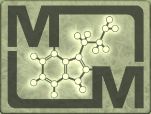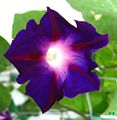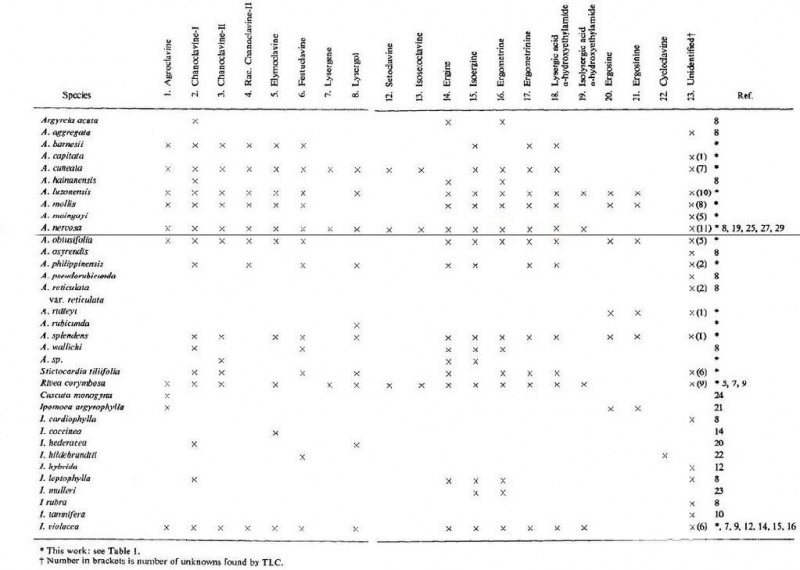 |
MAGISKA MOLEKYLERS WIKI |
Convolvulaceae
Namn: Vindev├żxter (sv), Bindweed (eng)
Inneh├źll
Generell information
Familjen har 58 sl├żkten och ungef├żr 1650 arter. I Sverige finns bara ett f├źtal arter ur tre sl├żkten naturligt.
Ett flertal arter och sl├żkten i familjen inneh├źller LSA och liknande ergotalkaloider. Andra inneh├źller tropaner.
Att man hittat ergotalkaloider i fr├Čn fr├źn olika arter i familjen beror p├ź att parasitsvampar lever i symbios med v├żrdv├żxten och sprider sig vidare med fr├Čna. Dessa parasitsvampar inneh├źller bl.a LSA.
| ŌĆ£ | Ergoline alkaloids (syn. ergot alkaloids) are constituents of clavicipitaceous fungi (Ascomycota) and of one particular dicotyledonous plant family, the Convolvulaceae. While the biology of fungal ergoline alkaloids is rather well understood, the evolutionary and biosynthetic origin of ergoline alkaloids within the family Convolvulaceae is unknown. To investigate the possible origin of ergoline alkaloids from a plant-associated fungus, 12 endophytic fungi and one epibiotic fungus were isolated from an ergoline alkaloid-containing Convolvulaceae plant, Ipomoea asarifolia Roem. & Schult. Phylogenetic trees constructed from 18S rDNA genes as well as internal transcribed spacer (ITS) revealed that the epibiotic fungus belongs to the family Clavicipitaceae (Ascomycota) whereas none of the endophytic fungi does. In vitro and in vivo cultivation on intact plants gave no evidence that the endophytic fungi are responsible for the accumulation of ergoline alkaloids in I. asarifolia whereas the epibiotic clavicipitaceous fungus very likely is equipped with the genetic material to synthesize these compounds. This fungus resisted in vitro and in vivo cultivation and is seed transmitted. Several observations strongly indicate that this plant-associated fungus and its hitherto unidentified relatives occurring on different Convolvulaceae plants are responsible for the isolated occurrence of ergoline alkaloids in Convolvulaceae. This is the first report of an ergot alkaloid producing clavicipitaceous fungus associated with a dicotyledonous plant. ŌĆö Steiner (2006)[1] |
ŌĆØ |
| ŌĆ£ | Because of the unusual fungus/trichome associations, the newly described fungal genus was named Periglandula [34]. The fungus is not yet cultivable in vitro, but it was possible to isolate the mycelial mats after ultrasonic treatment of the leaves. This technique gave access to further characterization of the fungi growing on I. asarifolia (white and red blooming varieties) and T. corymbosa. Phylogenetic trees constructed from the 18SrDNA and the internal transcribed spacer grouped the fungi from both plant species into the Hypochreales, which is home to the family Clavicipitaceae (18SrDNA), and into the Clavicipitaceae proper [35, 36]. Phylogenetic trees from the beta-tubulin (tubB), RNA polymerase II large subunit (rpbA), and mitochondrial ATP synthase subunit 6 (Atp6) gave Periglandula clades sister to Claviceps and Epichloe or Balansia and Epichloe, all of which are genera within the family Clavicipitaceae. The epibiotic fungi were named Periglandula ipomoeae U. Steiner, E. Leistner et Schardl (IasaFA13 or IasacredF01 depending on the white and red blooming host viariety, respectively) and Periglandula turbinae U. Steiner, E. Leistner et Schardl (TcorF01). A comparison of six genes from the Periglandula species collected from the white and the red blooming I. asarifolia plants revealed no significant sequence differences [34]. In a recent attempt to extend the knowledge to symbiotic systems from different climates and different continents, eight new Periglandula species symbiotic with Convolvulaceae host plants were reported. The occurrence of ergot alkaloids coincides in every case with the presence of a Periglandula species. In the phylogeny generated from the translation elongation factor-1alpha each fungus formed a monophyletic group with P. ipomoeae and P. turbinae with a node confidence of 91% [34, 37]. Analyses of ergot alkaloids grouped the newly discovered symbiotic systems into four different chemotypes [37]. Further study revealed in P. ipomoeae (IasaF13) the presence of a gene cluster containing 14 ergot alkaloid genes [38ŌĆō40] essential for the biosynthesis of ergopeptines and ergot alkaloids of the simple lysergic acid amide type, which are known to exert a hallucinogenic effect. These data leave little doubt about the source and fungal nature of ergot alkaloids in Convolvulaceae. ŌĆö Steiner (2018)[2] |
ŌĆØ |
Sl├żkten och arter
- Sl├żktet Argyreia
- Sl├żktet Convolvulus
- Sl├żktet Ipomoea
- Sl├żktet Merremia
- Sl├żktet Rivea
- Sl├żktet Stictocardia
Arter och inneh├źll
Klicka p├ź bilden h├żr ovan, och sedan p├ź bilden p├ź sidan du kommer till f├Čr se en h├Čguppl├Čst version. Se ├żven listor under artiklar om resp. sl├żkte.
K├żlla: "Identification of ergoline alkaloids in the genus Argyreia and related genera and their chemotaxonomic implications in the convolvulaceae Jew-Ming Chao and Ara H. DerMarderosian"
Tr├źdar p├ź Magiska Molekylers forum
V├żxter i familjen Convolvulaceae, psykoaktiva sl├żkten och arter.
Externa l├żnkar
- Ōåæ Molecular characterization of a seed transmitted clavicipitaceous fungus occurring on dicotyledoneous plants (Convolvulaceae). (Steiner, 2006)
- Ōåæ Ergot Alkaloids and their Hallucinogenic Potential in Morning Glories. (Steiner, 2018)
Sidan ├żndrades senast 31 mars 2018 klockan 13.49.
Den h├żr sidan har visats 8┬Ā620 g├źnger.

















